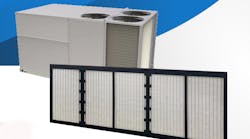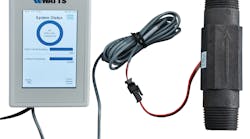The use of variable-frequency drives (VFDs) to control alternating-current (AC) motors has increased dramatically in recent years. In addition to featuring low operating costs and high performance, VFDs save energy. The challenge facing system designers and engineers is to minimize damage to AC motors from shaft current. From its first minute of operation, a VFD induces destructive voltages that build up on a motor shaft until they find discharge paths to the frame (ground). In most cases, motor bearings present the path of least resistance. Once voltage is sufficient to overcome the resistance of the oil-film layer on a bearing, shaft current discharges, causing electrical-discharge-machining pits and fusion craters in the race wall and ball bearings. This phenomenon continues until the bearings become so severely pitted that fluting, excessive noise, and failure occur. Mitigation of this damage is possible through various strategies. Some are narrow in application, and most are costly. Many are not technically feasible. However, a new technology employs a circumferential ring of conductive microfibers to discharge harmful currents and provide a low-cost solution to the problem.
VFDS INDUCE SHAFT CURRENTS IN AC MOTORS
Mainly because of an increased focus on energy savings, the use of pulse-width-modulated (PWM) VFDs to control AC motors has grown considerably over the past few years. While they offer plenty of benefits, VFDs are not without their problems.
Shaft currents induced by VFDs can lead to motor failures. Without some form of mitigation, shaft currents travel to ground through bearings, causing pitting, fusion craters, fluting, excessive bearing noise, eventual bearing failure, and subsequent motor failure.
This is not a small problem. Consider the following:
-
Most motor bearings are designed to last for 100,000 hr, yet motors controlled by VFDs can fail within one month (720 hr).1
-
Of the VFD-controlled, 30- to 60-hp vane-axial-fan motors an HVAC contractor installed on a large building project, all failed within a year (two within six months). Repair costs totaled more than $110,000.2
-
Several large pulp and paper companies surveyed noted that the VFD-controlled AC motors used in their plants typically fail within six months because of bearing damage.3
-
A large U.S. motor manufacturer has cited eliminating drive-related motor failures as its No. 1 engineering challenge.4
-
There are almost a dozen blogs on the Internet focused on discussing problems presented by VFD-induced shaft currents, sharing information and experiences, and suggesting solutions.
-
Motor failures caused by VFD-induced shaft currents result in hundreds of thousands of hours of unplanned downtime each year in the United States alone. In addition, these failures affect the performance and mean time between failure of the original-equipment-manufacturing systems in which they are used.
-
With an approximate 16-percent motor-price increase from 2005 to 2006 — caused by rising copper prices — this problem will become even more costly.5
ELECTRICAL DAMAGE TO BEARINGS
Because of the high-speed switching frequencies used in PWM inverters, all VFDs induce shaft current in AC motors. The switching frequencies of the insulated-gate bipolar transistors used in these drives produce voltages on the motor shaft during normal operation through electromagnetic induction. These voltages, which can register 70 v or more (peak to peak), are measured easily by touching an oscilloscope probe to a shaft while a motor is running (Photo A).
Once these voltages reach a level sufficient to overcome the dielectric properties of the grease in motor bearings, they discharge along the path of least resistance — typically the bearings — to the motor housing. (Bearings are designed to operate with a thin layer of oil between the rotating ball and bearing race.) During almost every VFD cycle, induced shaft voltage discharges from the motor shaft to the frame via the bearings, leaving a small fusion crater in the bearing race. These discharges are so frequent that, before long, the entire bearing race becomes marked with countless pits, known as frosting. As damage continues, the frosting increases, eventually leading to noisy bearings and bearing failure. A phenomenon known as fluting may occur as well, producing washboard-like ridges across the frosted bearing race. Fluting can cause excessive noise and vibration that, in heating, ventilation, and air-conditioning systems, is magnified and transmitted by the ducting. Regardless of the type of bearing or race damage that occurs, the resulting motor failure often costs many thousands or even tens of thousands of dollars in downtime and lost production.
Failure rates vary widely depending on many factors, but evidence suggests that a significant portion of failures occur only three to 12 months after system startup. Because many of today's AC motors have sealed bearings to keep out dirt and other contaminants, electrical damage has become the most common cause of bearing failure in AC motors with VFDs. If half of all AC-motor failures are caused by bearing failure, almost 80 percent of these are caused by electrical damage to bearings.6
New bearing race
Viewed under a scanning electron microscope, a new bearing race wall has a smooth surface (Photo B). As the motor runs, a track eventually forms where the bearing ball contacts the wall. Without electrical discharge damage, this type of mechanical wear would be the only cause of degradation.
Pitting
Photo C shows a frosted bearing race wall after 5,400 hr of continuous use in a VFD/AC motor system. Early damage typically takes the form of pitting. These fusion craters increase in number and size as each cycle of induced voltage discharges from the shaft through the bearings to the frame and ground. Soon, the entire race is covered with millions of pits. As new fusion craters form over old ones, a “frosted” surface that easily is visible to the naked eye appears.
Fluting
In a phenomenon known as fluting (Photo D), the operational frequency of a VFD causes concentrated pitting at regular intervals along the bearing race wall, forming a “washboard” pattern. This pattern results in vibration and noise. In an HVAC system, this noise can be transmitted throughout a facility via air ducts.
STRATEGIES FOR MITIGATING SHAFT-CURRENT DAMAGE
As demonstrated previously, electrical damage to VFD/AC-motor bearings begins at startup and grows progressively worse. As a result of this damage, the bearings eventually fail. To prevent such damage in the first place, the induced shaft current must be diverted from the bearings by insulation and/or an alternate path to ground.
Insulation
Insulating motor bearings is a solution that tends to shift the problem elsewhere as shaft current looks for another path to ground. Sometimes, because of the capacitive effect of ceramic insulation, high-frequency VFD-induced currents pass through the insulating layer and cause bearing failure. If an attached piece of equipment, such as a pump, provides this path, it often winds up with bearing damage of its own. Insulation and other bearing-isolation strategies can be costly to implement.
Alternate discharge paths
When properly implemented, these strategies are preferable to insulation because they neutralize shaft current. Techniques range in cost and sometimes can be applied only selectively, depending on motor size or application. The ideal solution would provide a low-resistance path from shaft to frame, cost relatively little, and be applied broadly across all VFD/AC-motor applications, affording the greatest degree of bearing protection and maximum return on investment.
SHAFT-CURRENT-MITIGATION TECHNOLOGIES
Although there are a number of technologies available to protect AC-motor bearings from damage caused by shaft currents, few meet all of the criteria of effectiveness, cost, and application versatility.
Faraday shield
The faraday shield prevents a VFD current from being induced onto a shaft by effectively blocking the current with a capacitive barrier between the stator and rotor. However, this solution is difficult and expensive to implement and generally has been abandoned as a practical solution.
Insulated bearings
Insulating material, usually a nonconductive resin or ceramic layer, isolates bearings and prevents shaft current from discharging through them to a frame. This forces current to seek another path to ground, such as through an attached pump or tachometer or even the load. Because of the high cost of insulating bearing journals, this solution generally is limited to larger-sized National Electrical Manufacturers Association (NEMA) motors. Sometimes, high-frequency VFD-induced currents actually pass through the insulating layer and cause bearing damage anyway. Another drawback is the potential for contaminated insulation, which can establish a current path through bearings over time.
Ceramic bearings
The use of nonconductive ceramic bearings prevents the discharge of shaft current. As with other isolation measures, shaft current will seek an alternate path to ground. This technology is costly. In most cases, motors with ceramic bearings must be special ordered and have long lead times. In addition, because ceramic bearings and steel bearings differ in compressive strength, ceramic bearings usually must be resized to handle mechanical static and dynamic loadings.
Conductive grease
In theory, because this grease contains conductive particles, it would provide a lower-impedance path through bearings and bleed off shaft current through bearings without a damaging discharge. Unfortunately, the conductive particles in these lubricants increase mechanical wear of bearings, rendering the lubricants ineffective and often causing premature failures. This method widely has been abandoned as a viable solution to bearing currents.
Grounding brush
A metal brush contacting a motor shaft is a more practical and economical way to provide a low-impedance path to ground, especially for larger NEMA-frame motors. However, these brushes pose several problems of their own:
-
They are subject to wear because of the mechanical contact with the shaft.
-
They collect contaminants on their metal bristles, which destroys their effectiveness.
-
They are subject to oxidation buildup, which decreases their grounding effectiveness.
-
They require maintenance on a regular basis, increasing their cost.
Shaft-grounding ring (SGR): This new approach involves the use of a ring of specially engineered conductive microfibers to redirect shaft current and provide a reliable low-impedance path from shaft to frame, bypassing motor bearings entirely. The ring's electron-transport technology uses ionization principles to boost the electron-transfer rate and promote efficient discharge of high-frequency shaft currents induced by VFDs. With hundreds of thousands of discharge points, an SGR channels shaft currents around AC motor bearings and protects them from electrical damage. An SGR is a low-cost solution that can be applied to almost any size AC motor in almost any VFD application.
An SGR offers a combination of benefits, including scalability, easy installation and maintenance, low cost, and high return on investment.
Scalability
The SGR was designed for motors with shafts from 0.311 to 6.020 in., including NEMA and International Electrotechnical Commission frames, as well as high-horsepower AC and DC motors. SGRs have been used for power generators, gas turbines, wind-turbine generators, AC traction and break motors, cleanrooms, HVAC systems, and other industrial and commercial applications.
Installation and maintenance
An SGR is installed by sliding the ring over either end of a motor shaft and locking it in place with screw-on mounting brackets. No machining is required. Once installed, an SGR requires no maintenance. With no parts to wear out, an SGR lasts as long as bearings. A split-ring design allows installation around a shaft without disassembling attached equipment.
Low cost and high return on investment
Typically, an AC motor coupled with a VFD costs from $2,400 to $100,000 or more and may be part of a manufacturing process that generates revenues from $10,000 to $1 million or more per hour. The cost of installing an SGR in a VFD/AC-motor system is low when compared with the cost of the overall system — usually, less than 1 percent of the equipment cost. By preventing electrical damage to bearings, an SGR protects a VFD system from the costly downtime of unplanned maintenance. In some production applications, even a momentary stoppage caused by motor failure can cost more than $250,000, excluding the cost of repairing the motor.
Motor manufacturers and process engineers in industries in which VFDs are used are aware of the problems and expense caused by electrical damage to bearings. They have expended a significant amount of time, effort, and money to find a solution to this problem. An SGR is the most effective and universally applicable solution.
REFERENCES
-
Muetze, A., Binder, A., Vogel, H., & Hering, J. (2004, October). Experimental evaluation of the endangerment of ball bearings due to inverter-induced bearing currents. Paper presented at the IEEE/IAS 39th Annual Meeting, Seattle, WA.
-
(Conversation with mechanical contractor, 2006.)
-
(Conversations with reliability engineers, 2006.)
-
(Conversation with product engineer, 2006.)
-
(Conversations with motor suppliers, 2006.)
-
Snyder, D.R. (2007, February). How to prevent electrical erosion in bearings. Pumps & Systems. Retrieved from http://www.pump-zone.com/article.php?articleid=322
For past HPAC Engineering articles, visit www.hpac.com.
General manager of Electro Static Technology, William Oh has extensive design and application experience in automation and product development, specializing in the mitigation of unwanted electrical currents. A member of the Illinois Tool Works Patent Society, he holds degrees in mechanical engineering from Pusan National University and the Korean Advanced Institute of Science and Technology. For three years, he was a visiting researcher at the University of Massachusetts.








